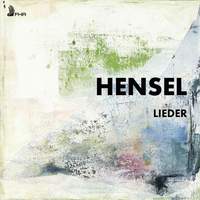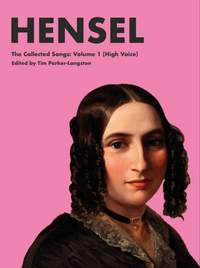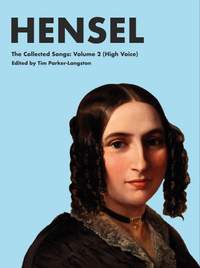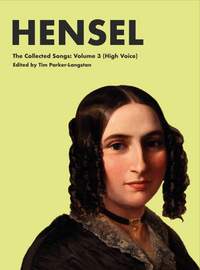Interview,
Tim Parker-Langston on Fanny Hensel's Lieder
Last month Tim took time out from labouring on the final stretches of his doctoral thesis on Hensel to tell me more about ‘reparative musicology in action’, the experience of recording at the Mendelssohn-Haus in Leipzig, and why he believes that Hensel is 'an entirely singular creative voice that never stops surprising us'...
This recording (and the editions of the songs which you've recently published) grew out of your PhD on Hensel's Lieder - tell me a little more about your thesis and the genesis of the album...
My doctorate has all been centred around performing these songs, and making the materials necessary for performing them accessible: it’s very hard to sing a song if you don’t have a score! The idea is to share insight of what that process involves, but also to make a tangible difference as to what people can perform and hear. At the beginning in 2020 there were over 100 songs from her 240 which hadn’t been recorded, which is a staggering amount for someone who is arguably the most famous female composer. None of these songs were published during her lifetime; some have been published elsewhere since I did my edition, but others appear here for the first time.
The aim of the recording was to make a substantial dent in that number, and I began just by speaking to various friends and colleagues I’ve made over the last decade of my performing career; everyone I approached shared that interest, and we recorded some of the songs for YouTube during lockdown. First Hand Records enjoyed them, and the ball really got rolling when the Mendelssohn-Haus offered their space to us for the recording. Once we’d booked some dates we set about crowdfunding the recording: the Ambache Charitable Trust was one of our most significant donors, and we managed to get everyone flown out and accommodated!
How much of the house has been preserved, and where exactly did you record?
They have the original house where Felix lived, although ‘house’ is a very modest word – it could be a block of flats in terms of scale! It’s incredibly well-preserved, with the original staircases and rooms still intact, and the top floor of the museum is dedicated to Fanny’s compositions and life. They’ve also turned what used to be the stables during Fanny and Felix’s lifetime into this beautiful long recital-space looking out across the garden, and that turned out to be the best place to record: in the little salon in the Mendelssohn-Haus itself the acoustic is so vibrant that recording there would be nigh-on impossible.
Although the space didn’t exist in the same sense during Fanny’s lifetime, there was something very special about putting your feet where her feet trod. And Leipzig itself is magical – it has that real feeling of musical history because there were so many heavy-hitters concentrated into such a small area!
Do we know how many of these songs were performed during her lifetime?
Documentation of salon culture in general is remarkably scarce, so it’s hard to pin down what was performed and heard, and the records of Fanny’s Sunday concerts are almost exclusively focused on music by other featured composers. Those concerts were a very serious professional project for her, almost like a Wigmore Hall-style subscription series: although they were technically private events, they had written programmes and people sat in attentive silence.
I imagine quite a lot of these songs wouldn’t have been the sort of things that she was performing in that context, because she was trying to focus on larger genres. They may well have just been sung through at the piano on her own or with her sister, maybe for the family, in a more unofficial gathering than the salon - or they could literally have been just the result of a day’s labours, never to be revisited even by her.
Although the written records are scant, a lot of the autograph manuscripts have been preserved. While some of them are written very assuredly, with no kind of annotation or correction, there’s an almost diary-like quality to them in that they’re obviously records of ideas she’d been developing for some time. Because she did publish some songs, we know which ones she considered to be most representative of her style, and many of those have got editorial scribblings as she prepared them before passing them on to the publisher.

With so many unrecorded songs to choose from, how did you go about putting the programme together?
I wanted to get a sense of representing her in a quite varied way, as one of the things I’ve found from immersing myself in the whole repertoire is just how much her style differentiates from what you might perceive from those few published songs. Because they resemble what we think of as Lieder - slightly more virtuosic piano-parts, a certain descriptive quality - they fit nicely alongside the songs that we quite rightfully love by her male contemporaries like Schubert or Schumann.
But those on their own only represent a portion of what she actually does, so I was keen to unveil some of the things that maybe had not been approached because they didn’t fit that box. At the same time I didn’t want to misrepresent or editorialise her musical voice by shying away from those songs that we are familiar with, so I worked out a proportion of some of the ‘hits’ alongside some new material. Eventually the idea of bringing the songs that resided in a private sphere during her lifetime together seemed quite nice.
In terms of specific choices, it was fairly easy given that I’d spent so much time playing, singing and editing all 240 songs: as with a favourite band or album, certain things always stick out to you, and every time I came across a dog-eared page I took that as a sign to include that song! Some were things that I knew I wanted to sing myself, and others were songs I knew that someone else would do really well; having access to other voice-types was part of the pleasure of the project.
Were you also keen to present a cross-section of the various poets who inspired her?
Fanny was quite helpful to me in that regard, because she frequently set poets in chunks – she’d give her attention to one poet for the best part of a year and then not really revisit them, so the chronological approach ends up working quite nicely by default. I think the most deliberate poetic focus is a chunk of songs written about 1827/28, setting texts of Christoph Heinrich Hölty: quite a few of those are premieres, and I think they represent a real sweet spot of her developing style.
Which composers and fellow musicians particularly influenced that developing style?
I think one of the most inspirational voices in music, from the beginning to end of her career, is JS Bach. She was intricately involved in the Bach revival with Felix (she sang alto in the St. Matthew Passion performance which Felix conducted in 1829) and her composition tutor Carl Friedrich Zelter was a great proponent of Bach too. I think that language really resonated with her (perhaps to an even greater degree that it did for Felix), and she has a real gift for employing that chorale-style writing and counterpoint. There are several songs which have that Baroque sound which I think is quite unusual in Lieder, and that was definitely something I wanted to bring out on the disc.
The other side of her style is this exceptionally expressive Romanticism, and it’s hard to know whether it was people or travel that was more influential there. She spent a year in Italy in 1839/40, and she had lots of salon gatherings out there; one of the participants was Gounod, who was a huge supporter of her work (and in fact misappropriated several of Felix’s pieces to Fanny!). His operas and vocal writing in general have a very late-Romantic feel, and I think that must’ve made some sort of impression.
Then there’s Felix’s music, of course: they had a lovely collaborative musical relationship in their early years especially, and they’d pass notes back and forth about their compositions throughout their lives. And she had some pretty epic musicians come to her Sunday musicals, including Liszt and possibly Rossini. She and Felix also saw a lot of Weber performances when they were younger and I think that sort of butch, late-Classical, more Beethovenian style had quite an impact on them both: there’s definitely an impressive sense of drama and scale in her music, even in compositions for just voice and piano.
Did any real curve-balls hit you along the way?
Two songs on the album come to mind straight away – one is called ‘Die Schönheit nicht, O Mädchen!’, which was written quite early on and is very Mozartian. There’s so much of Die Zauberflöte in it – there’s no pretence of it being an individual musical voice, but it’s very charming.
At the opposite end of the scale, there’s one of the many Sehnsucht poems which she set, HU205: it’s a single page, maybe just 7 or 8 bars, and it is incredibly experimental and bizarre. When we were recording it, the pianist Ewan and I decided that we just had to embrace the strangeness! I was rehearsing yesterday with Genevieve, one of the other pianists on the recording, and we were saying that she just never stops surprising us. Once you start digging into this music, you find that even the songs that look quite simple reveal themselves to have quite bold formal shapes if you’re guided by what the piano-part or the dynamics do and are prepared to take a few risks…
Do you have any live performances of her music coming up?
I include some of her songs in every recital I give now. Centralising actually doing things and integrating musical practice into your research is an effective way of making real impact – a performance makes noise in a space in front of people, and there is something tangible about that. The term that I’m playing around with is ‘reparative musicology in action’, which is grounded in feminist musicological theory: Sally Macarthur and Suzanne Cusick both use the term ‘reparative musicology’, and it was Eve Kosofsky Sedgwick who introduced the idea of ‘reparative’ versus ‘paranoid’ readings - in a nutshell, it’s the idea that your scholarship is working towards positive outcomes, almost like a kind of activism.
The big news is a project called #HENSEL, which has harnessed the power of social media and the internet to get the remaining songs recorded. All 89 of the unrecorded songs have now been allocated to musicians all over the world (including members of the Presto team!), who will be making DIY recordings that will be hosted through my site henselsongsonline.org.
Many of the performers will be programming them alongside songs by other people, because one thing I’m keen to get away from is seeing this music confined to recitals which focus exclusively on female composers. This happens at even the biggest concert-halls, and it reinforces the idea that it’s still ‘Other’ - that it doesn’t belong there in its own right, and doesn’t hold up to scrutiny.
What sort of responses have you had from concert-programmers, colleagues and audiences?
One of the questions I get asked the most is ‘But is it any good?!’. There still seems to be this anxiety that if we put these things together people will think ‘OK, but it’s not Dichterliebe!’. Of course it isn’t – there’s only one Dichterliebe, but you can’t just do concerts of this small handful of pieces.
Musicology begins from a position of advocacy for the quality of something, and I think that embracing someone’s complete works is a very powerful statement. Of course they’re not all as musically enjoyable as each other – the good ones wouldn’t be great if there wasn’t something special about them - but you could say the same of Schubert or Schumann! I’ve had only overwhelmingly positive responses to the music itself from audiences.
I’m (hopefully!) nearing the final stretches of my doctorate now, and fielding the ‘What have you learned during your PhD?’ questions quite regularly…My elevator-pitch is simply that Hensel writes songs like no-one ever had or ever has since. She is an entirely singular creative voice, and there’s so much of it – it’s a gift to audiences and performers alike.
Jennifer Parker, Stephanie Wake-Edwards (mezzos), Tim Parker-Langston (tenor), Jâms Coleman, Genevieve Ellis, Ewan Gilford (piano)
Available Formats: CD, MP3
Edited by Tim Parker-Langston
Available Format: Sheet Music
Edited by Tim Parker-Langston
Available Format: Sheet Music
Edited by Tim Parker-Langston
Available Format: Sheet Music








